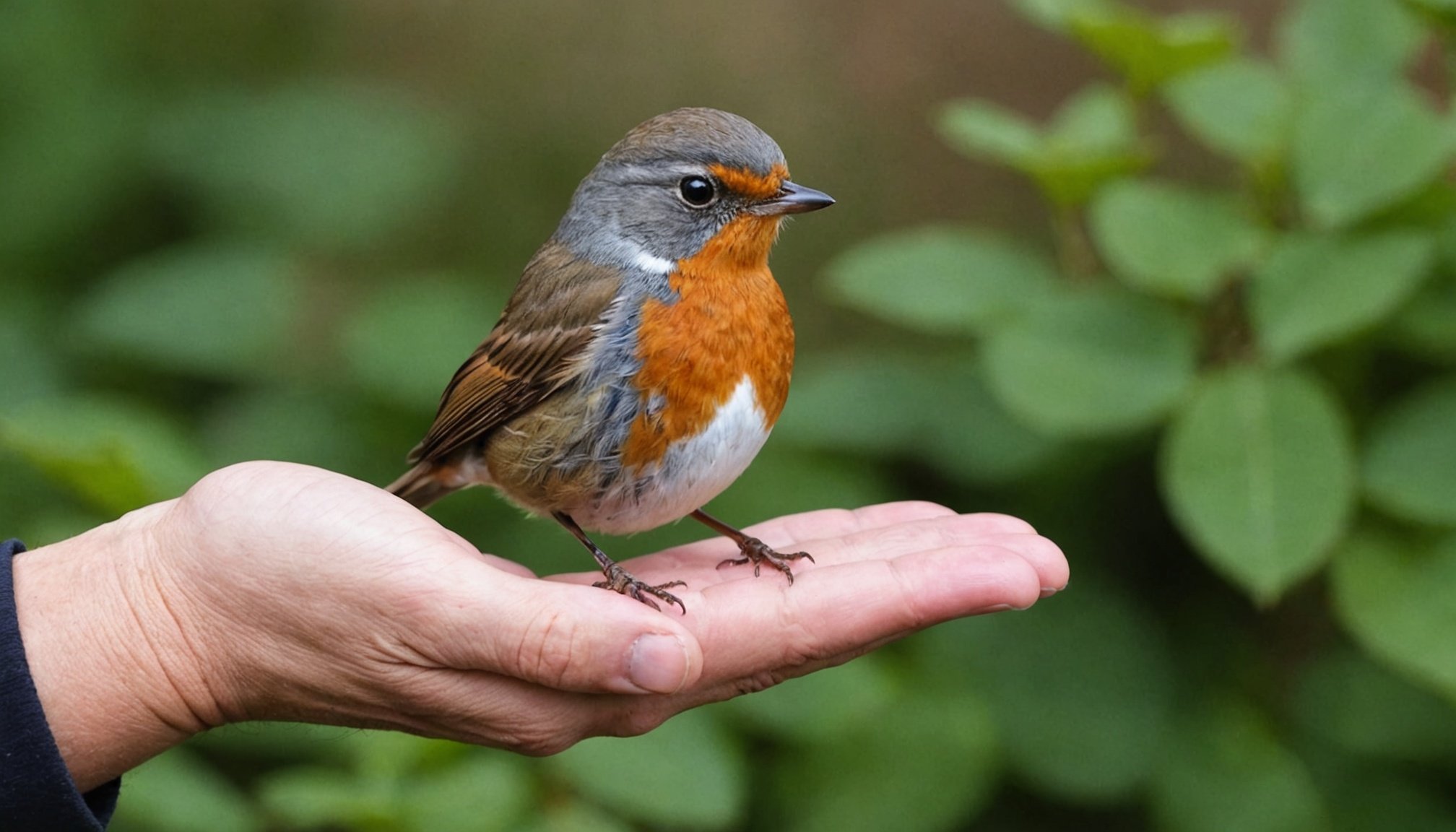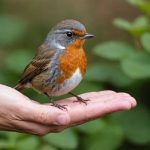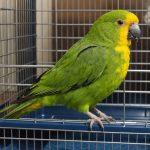Understanding British Robins
British robins are one of the most cherished species in the UK, known for their distinctive red breasts and melodic songs. Understanding their characteristics and habitat needs is vital for their conservation and appreciation.
These charming birds are primarily recognized for their bright red chests, which contrast beautifully with their brownish backs and white bellies. British robins are relatively small, measuring about 14cm in length, with an average wingspan of 20-22cm. Their friendly demeanor often leads them to approach humans, especially in gardens during the winter months.
Also read : Top Proven Strategies to Stop Feather Plucking in Your Pet Birds
Robins thrive in a variety of habitats, from woodlands and hedgerows to gardens and parks. Their habitat needs are quite flexible, allowing them to adapt to changing environments. However, they require dense vegetation for nesting and open ground for foraging. Primarily, robins feed on a diet of insects, worms, and fruit, relying on a rich environment to support their dietary requirements.
Understanding the natural behavior and habitat needs of British robins helps us create environments that support their survival and well-being. By recognizing their habitat preferences and dietary needs, we can ensure these delightful birds continue to thrive in diverse landscapes, bringing joy to all who encounter them.
In the same genre : Essential Tips for Ensuring Your Pet Bird Feels at Home in Its Travel Carrier
Preparing for Orphaned Robin Care
Before embarking on the journey of orphan care for robins, ensuring you have the right supplies needed is crucial. Essential items include a suitable container for the nursery setup, such as a small box or a basket, lined with soft material like tissues or a towel to maintain warmth and comfort. Providing a safe environment encompasses safeguarding the area against predators and ensuring it has adequate ventilation.
A critical necessity is a reliable heat source, since young robins require a warm environment to thrive. A lamp fitted with a low wattage bulb or a heating pad can serve effectively here. Moreover, maintaining proper hygiene is vital to prevent any infections or illnesses. Clean the nursery setup regularly and always wash your hands thoroughly before handling the birds.
Creating a suitable environment also involves ensuring safety measures are in place. Place the nursery in a quiet location free from loud noises or disturbances, which can stress the robin. Regularly monitor temperature levels to keep them consistent. By focusing on these key aspects and being meticulous with the supplies needed, you are well-equipped to provide the best orphan care for robins.
Feeding Techniques for Orphaned Robins
Caring for orphaned robins can be challenging, especially when it comes to meeting their dietary needs. Understanding their recommended diet is essential for their health and survival. Young robins require a varied diet, mimicking their natural feeding patterns. Typically, insects such as mealworms or earthworms form a significant part of their intake, providing the necessary protein.
Diet options should include finely chopped fruits like apples or berries, supplemented with specialized baby bird food available at pet stores. Ensure the food is soft and easy to consume, as young robins are not yet adept at eating.
Establishing a consistent feeding schedule is crucial. Orphaned robins should be fed every 30 to 45 minutes during daylight, gradually extending intervals as they grow. Use a small syringe or dropper to deliver food, carefully placing it near the beak’s back for effortless swallowing.
Common mistakes include overfeeding, which can lead to health issues, or providing improper foods that lack nutrients. Avoid giving milk or bread, as these can be harmful. Being informed and cautious will enhance the well-being of these delicate creatures, ensuring they develop healthily and are ready for eventual release into the wild.
Monitoring Health and Growth
Successfully raising orphaned robins involves understanding and monitoring their health and growth milestones. Key health indicators provide vital insights into their wellbeing. It’s crucial to observe their activities such as feeding behaviour, which should be consistent and active. If a robin shows reluctance to eat, it might be exhibiting signs of distress or illness.
Growth milestones mark the stages of healthy development. For instance, robins typically start to stand with voracity within the first week. Their wings should begin to flutter as they attempt short flights around two weeks. These milestones indicate proper development, signalling they’re on track.
Conversely, recognising signs of distress is equally important. Symptoms like lethargy, persistent crying, or laboured breathing require immediate attention. Addressing such issues promptly by consulting a veterinary specialist ensures they receive the necessary care and interventions.
By maintaining a diligent health monitoring routine and keeping abreast of these developmental milestones, caregivers can provide orphaned robins with the best chances for a healthy growth trajectory and subsequent release back into their natural habitat. Through this proactive approach, robins’ chances of survival and thriving improve significantly, enabling a smoother transition into the wild.
Behavioral Care and Socialization
Understanding typical robin behavior is crucial in the rehabilitation process. Robins require specific care that mimics their natural environment to ensure they develop appropriately. When in care, these birds need environments that resemble their natural habitats, enabling them to familiarize both instinctual and observable actions before release back into the wild.
Socialization techniques are fundamental to rehabilitation. These include controlled interactions that encourage robins to acclimate to human presence while maintaining their natural wariness. Handlers often use indirect interaction methods, allowing robins to observe humans frequently but with limited direct contact. This balances their comfort around humans without compromising their wild instincts. Such interactions aim to foster a sense of safety and trust so robins can respond appropriately to human presence in the future.
Preparing robins for eventual release entails a gradual acclimation to outside conditions. This can include progressive exposure to environmental elements, leading to increased independence while still under human supervision. By judiciously implementing socialization techniques, conservationists assist robins in developing the behavioral traits necessary for thriving post-release, ultimately ensuring that they can return to compatibly integrate into their natural habitat.
Challenges in Rearing Orphaned Robins
Rearing orphaned robins presents several common challenges, often requiring both patience and knowledge to ensure their survival and healthy development. One prominent challenge is providing an appropriate diet. Orphaned robins require a diet rich in earthworms, fruits, and insects to mimic what they would naturally consume. Failure to supply these essential nutrients may hinder growth and proper nutrition.
Another obstacle for caregivers is the maintenance of optimal temperature and habitat conditions. Young robins are sensitive to temperature changes, necessitating a warm and secure environment. A simple heat lamp can effectively simulate the warmth and protection of a parent bird’s brood patch.
Expert insights also highlight the importance of socialization and stimulation. Robins in the wild learn behaviours and survival skills from their parents and flock. Thus, caregivers must engage them in interactive activities fostering these natural behaviours.
Wildlife rehabilitators emphasize the importance of understanding robin vocalizations and encouraging communication. As birds are social creatures, ensuring regular vocal interaction can aid in their development.
Practitioners recommend the consistent monitoring of a robin’s health, looking for signs of distress or illness. Immediate professional consultation is advised if any concerns arise, ensuring the young bird receives appropriate care.
Resources and Further Learning
As you explore the fascinating world of bird rehabilitation, accessing resources for bird care is crucial for gaining knowledge. Whether you’re a novice or a seasoned enthusiast, recommended books, websites, and online communities provide valuable insights.
Books: A wealth of information is available in literature. Notable publications on bird care often include guides on habitat creation, species-specific needs, and behavioral understanding. These texts are often authored by experts in ornithology who provide invaluable, experience-backed tips for bird rehabilitation.
Websites: Online platforms host a myriad of useful websites dedicated to wildlife and bird care. These sites typically offer updated articles, care techniques, and community forums where you can ask questions and share experiences with fellow bird enthusiasts worldwide.
Communities: Engaging in online communities provides mutual learning and support. Platforms like birdwatching forums or social media groups are rich with fellow wildlife lovers willing to share experiences, advice, and moral support on your rehabilitation journey.
Continued learning is vital in the ever-evolving field of wildlife care. It enables enthusiasts to stay informed on the latest techniques and discoveries, ensuring you provide the best care possible for our feathered friends, thereby enhancing your skills and minimizing the stress and challenges faced by birds in need of human intervention.










